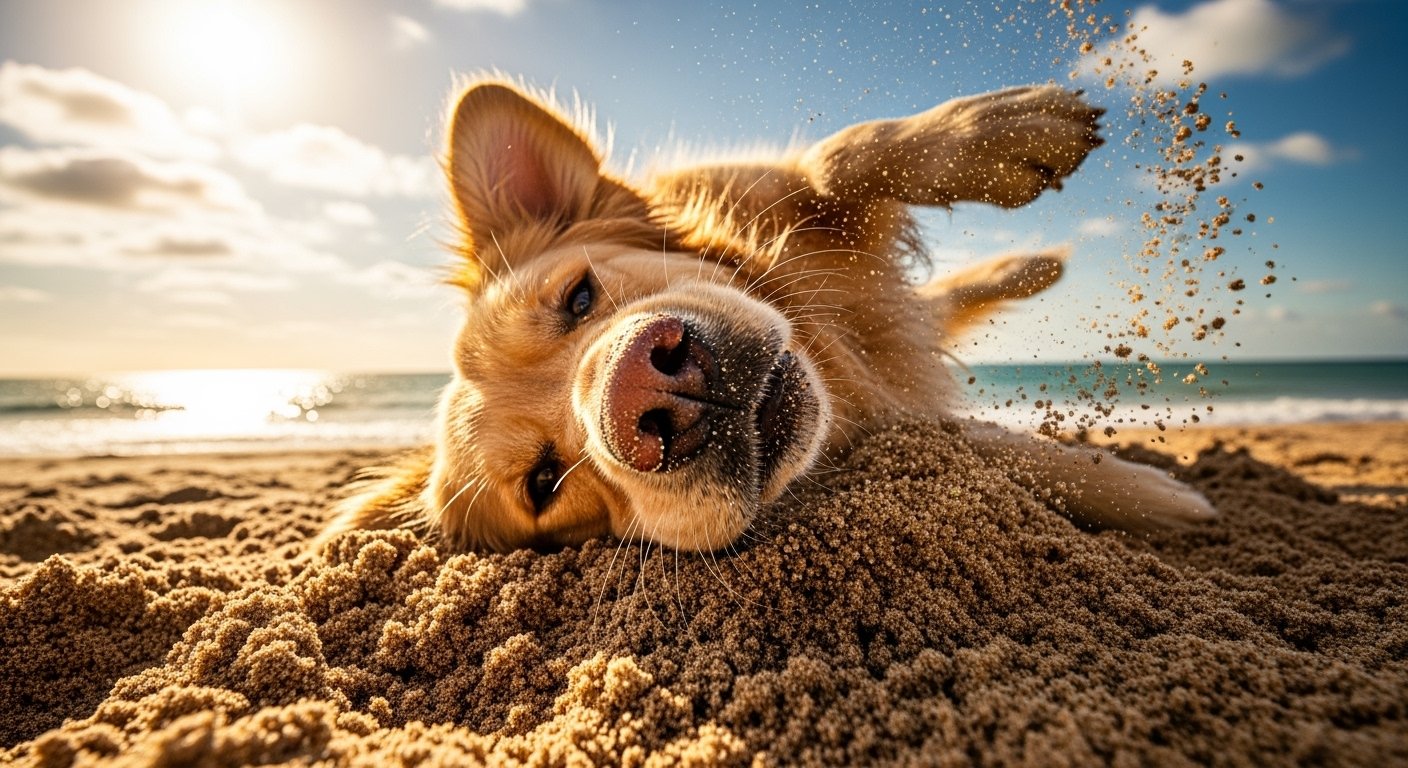Can Dogs Get Sunburn on Their Noses? Your Complete Protection Guide
When you’re planning that perfect beach day or hiking adventure with your furry companion, sunscreen for yourself is probably already on your checklist. But have you ever wondered if your dog needs sun protection too? The answer might surprise you – yes, dogs absolutely can get sunburn, and their noses are particularly vulnerable spots that need your attention.
Just like humans, our canine friends can suffer from painful sunburn that leads to serious health complications if left untreated. Those adorable pink noses, especially on light-colored breeds, are essentially targets for harmful UV rays. Understanding how to protect your dog from sun damage isn’t just about comfort – it’s about preventing long-term skin damage and potential skin cancer.
Whether you’re a new dog parent or have been caring for pets for years, this comprehensive guide will walk you through everything you need to know about canine sun protection. From identifying which dogs are most at risk to choosing the right dog sunscreen products, we’ll cover the essential information that every responsible pet owner should understand.
Understanding Canine Sunburn: The Basics Every Dog Owner Should Know
Dogs experience sunburn much the same way humans do, but their natural fur coat provides only partial protection. The reality is that certain areas of your dog’s body – particularly the nose, ears, belly, and areas with thin or light-colored fur – remain vulnerable to UV radiation damage.
Dr. Bradley Krohn, veterinarian with The Vets, explains: “Dog sunscreen serves the same purpose as it does in humans — to protect the skin from damage caused by prolonged exposure to the sun’s harmful UV rays. Dogs can develop skin cancer just like their owners, making prevention crucial.”
The science behind dog sunburn is straightforward. UV rays penetrate unprotected skin, causing cellular damage that manifests as redness, inflammation, and pain. Over time, repeated sun exposure without protection can lead to more serious conditions including skin cancer, premature aging, and permanent skin damage.
What makes dog nose sunburn particularly concerning is the location. A dog’s nose is constantly exposed when they’re outdoors, and many dogs have naturally pink or light-colored nose leather that lacks the protective pigmentation found in darker noses. This makes them prime candidates for sun damage during outdoor activities.
Pet sunscreen isn’t just a luxury item – it’s become an essential part of responsible pet care, especially for dogs who spend significant time outdoors. Understanding your dog’s individual risk factors will help you determine the level of protection they need.
Which Dogs Are Most at Risk for Nose Sunburn?
Not all dogs face the same level of sunburn risk. Several factors determine how susceptible your furry friend might be to UV damage, with coat color and skin pigmentation playing the most significant roles.
Light-colored and white dogs top the list of sun-sensitive breeds. Dogs with white, cream, or very light-colored coats typically have less melanin in their skin, which naturally protects against UV radiation. Breeds like Bull Terriers, Dalmatians, Whippets, and white German Shepherds often have pink noses that burn easily.
Dogs with thin or sparse coat coverage also face increased risk. Chinese Crested dogs, Mexican Hairless dogs, and any breed with naturally thin fur around the nose area need extra protection. Even thick-coated breeds can be vulnerable if they have light-colored skin beneath their fur.
Veterinary dermatologists note: “Animals that have light-colored noses and thin, very short, or missing fur are most in need of protective sunscreen. The lack of pigmentation means there’s less natural protection against harmful UV rays.”
Senior dogs deserve special attention when it comes to sun protection. As dogs age, their skin becomes thinner and more vulnerable to damage. Older dogs who have spent years in the sun without protection may already have compromised skin that burns more easily.
Dogs with existing skin conditions or those recovering from injuries around the nose area need careful monitoring. Any dog with recent wounds, surgical sites, or skin allergies affecting the nose should avoid direct sun exposure until fully healed.
Even if your dog doesn’t fit these high-risk categories, any pet spending extended time outdoors during peak sun hours (10 AM to 4 PM) can benefit from nose protection. The intensity of UV rays varies by geographic location, altitude, and season, so local conditions should influence your protection strategy.
Recognizing the Warning Signs: Symptoms of Dog Nose Sunburn
Early detection of sunburn symptoms can prevent minor skin irritation from developing into serious health issues. Knowing what to look for helps you respond quickly and appropriately to protect your dog’s health.
Redness and inflammation are typically the first visible signs of sunburn on a dog’s nose. The affected area may appear pinker or redder than usual, similar to how human skin looks after too much sun exposure. This redness might be subtle at first, especially on dogs with naturally pink noses.
Heat and tenderness accompany the visual changes. When you gently touch your dog’s nose, sunburned skin will feel warmer than normal and your dog may show signs of discomfort or pull away from your touch. Some dogs become head-shy when their nose is painful.
Skin texture changes develop as the burn progresses. You might notice the skin becoming rough, dry, or beginning to flake and peel. In more severe cases, the nose leather may crack or develop small wounds that could become infected without proper care.
Emergency veterinarians warn: “In cases of mild sunburn, redness, inflammation and flaking is often seen that can be managed with cool compresses. For more severe cases, urgent veterinary attention may be needed to prevent deterioration.”
Behavioral changes often accompany physical symptoms. Dogs with sunburned noses may paw at their face, rub their nose against furniture or carpet, or show reluctance to go outside. Some dogs become less interested in food if their nose pain interferes with their ability to smell properly.
Severe sunburn symptoms require immediate veterinary attention. Watch for blistering, open wounds, excessive swelling, or signs of infection like pus or a foul odor. Dogs may also develop fever, lethargy, or dehydration with serious burns.
The progression from mild to severe sunburn can happen quickly, especially in vulnerable dogs. What starts as slight pinkness in the morning can become painful, inflamed skin by evening with continued sun exposure. This is why prevention is always preferable to treatment.
Choosing the Right Dog Sunscreen: Safety First
Selecting appropriate sun protection for your dog requires understanding the crucial differences between human and pet-safe products. Using the wrong sunscreen can be dangerous or even toxic to your furry friend.
Never use human sunscreen on dogs. Many human sunscreen formulations contain ingredients that are toxic to pets, including zinc oxide, PABA (para-aminobenzoic acid), and salicylates. Dogs naturally lick their skin, and ingesting these chemicals can cause serious poisoning requiring emergency veterinary treatment.
Look for pet-specific sunscreen products that have been formulated with canine safety in mind. These products use ingredients that won’t harm your dog if they lick the application area. Quality dog sunscreens will clearly state they’re safe for pets and list all active ingredients.
Veterinary recommendations emphasize: “Generally, we recommend an SPF of 30 or higher, as well as a fragrance-free product because dogs and humans have different sensitivities to fragrance. It should also be waterproof if they are doing any outdoor activity.”
SPF 30 or higher provides adequate protection for most dogs in typical outdoor conditions. Higher SPF numbers offer incrementally better protection, but the difference between SPF 30 and SPF 50 is less dramatic than the jump from no protection to SPF 30.
Water-resistant formulas are essential for active dogs or those who enjoy swimming. Regular sunscreen washes off easily with water, sweat, or normal activity. Water-resistant products maintain their protective properties even when your dog gets wet or exercises vigorously.
Fragrance-free options are gentler on sensitive canine skin and won’t interfere with your dog’s powerful sense of smell. Strong fragrances can be overwhelming or irritating to dogs, potentially causing them to resist application or try to lick the product off.
Mineral-based active ingredients like titanium dioxide offer a safer alternative to chemical UV filters. These physical sunblocks sit on top of the skin and reflect UV rays rather than being absorbed into the skin, reducing the risk of irritation or toxic reactions.
How to Apply Dog Sunscreen: Step-by-Step Guide
Proper application technique ensures maximum protection while keeping your dog comfortable and cooperative during the process. Most dogs can learn to tolerate and even enjoy their sunscreen routine with patience and positive reinforcement.
Start the application process 15-20 minutes before sun exposure. This timing allows the sunscreen to fully absorb into the skin and create an effective protective barrier. Rushing out immediately after application reduces the product’s effectiveness.
Clean the nose area gently before applying sunscreen. Use a damp cloth to remove any dirt, debris, or previous sunscreen residue. This ensures better adhesion and prevents trapping contaminants under the new application.
Apply a thin, even layer covering the entire nose leather and any exposed pink skin around the nostrils. Don’t forget the top of the nose bridge if your dog has light-colored fur there. A little product goes a long way – over-application can make dogs more likely to lick it off.
Professional application tips: “Apply two layers at least 15 minutes before your pet goes outside, discourage them from licking it off, and remember to reapply as necessary throughout the day.”
Distract your dog during the absorption period to prevent immediate licking. Offer a special treat, engage in a brief training session, or provide a favorite toy to keep their attention away from their nose while the sunscreen sets.
Reapply every 4-6 hours or more frequently if your dog has been swimming, playing in water, or exercising heavily. Even water-resistant formulas lose effectiveness over time and with activity. Set phone reminders to maintain consistent protection throughout long outdoor days.
Monitor your dog’s reaction during and after application. Some dogs may experience mild skin sensitivity even with pet-safe products. Watch for excessive scratching, redness, or swelling that wasn’t present before sunscreen use, and discontinue use if irritation occurs.
Make it a positive experience by pairing sunscreen application with activities your dog enjoys. Many dogs learn to associate the routine with fun outdoor adventures, making future applications easier and less stressful for everyone involved.
 Alternative Protection Methods: Beyond Sunscreen
Alternative Protection Methods: Beyond Sunscreen
While dog-safe sunscreen provides excellent protection, combining multiple strategies creates the most comprehensive defense against harmful UV rays. These additional methods can enhance your sun protection plan or serve as alternatives when sunscreen isn’t practical.
Seek shade during peak sun hours whenever possible. The sun’s rays are strongest between 10 AM and 4 PM, making this the most dangerous time for unprotected sun exposure. Plan outdoor activities for early morning or late afternoon when UV intensity is lower.
Protective clothing and accessories offer physical barriers against sun damage. Specialized dog sun hats, visors, and UV-protective clothing are available for dogs who tolerate wearing accessories. These products work especially well for dogs with multiple sun-sensitive areas beyond just the nose.
Create portable shade with beach umbrellas, pop-up canopies, or dog-specific sun shelters during outdoor adventures. Having a shaded retreat available allows your dog to cool down and escape direct sun exposure during extended outdoor time.
Holistic protection approach: “Natural products like Snout Soother contain SPF ingredients while also providing healing properties for already damaged skin. These balms can prevent future burns while treating existing dryness and irritation.”
Limit exercise intensity during hot, sunny weather. Intense physical activity increases your dog’s body temperature and can make them more susceptible to heat-related problems. Choose gentler activities during peak sun hours and save vigorous exercise for cooler parts of the day.
Gradual sun exposure helps build tolerance in dogs who aren’t accustomed to spending time outdoors. Start with short periods in the sun and gradually increase exposure time while monitoring for any signs of skin irritation or burning.
Stay hydrated and watch for signs of heat exhaustion, which often accompanies sunburn risk. Provide fresh water frequently and watch for excessive panting, drooling, or lethargy that might indicate your dog is overheating.
Consider indoor alternatives on extremely hot, sunny days. Interactive toys, training sessions, or indoor play can provide mental and physical stimulation without sun exposure risks. Your dog’s safety should always take priority over outdoor activities.
Treating Sunburn: When and How to Help Your Dog
Despite your best prevention efforts, sunburn can still occur. Knowing how to provide appropriate first aid and when to seek professional veterinary care can make a significant difference in your dog’s recovery and comfort.
Immediate first aid for mild sunburn focuses on cooling and soothing the affected skin. Move your dog to a cool, shaded area immediately and apply cool (not cold) compresses to the burned nose. Soak a clean cloth in cool water and gently hold it against the affected area for several minutes at a time.
Cool water treatments can provide significant relief. Some pet owners find success with cool water in a spray bottle, lightly misting the burned area. Avoid ice or extremely cold water, which can actually damage already compromised skin and cause additional pain.
Veterinary first aid guidance: “Klein advises that any time sunburn is visible as reddened, warm, or flaking skin, you should move your dog inside (or at least into the shade) as quickly as possible. Cool compresses may soothe the skin to help relieve initial symptoms.”
Aloe vera gel can provide soothing relief for minor burns, but only use products specifically labeled as safe for pets. Human aloe products often contain additional ingredients that can be harmful to dogs. Apply a thin layer and monitor your dog to ensure they don’t lick it off excessively.
Prevent further damage by keeping your dog indoors or in complete shade until the burn heals. Even mild sunburn makes skin more sensitive to additional UV exposure, and what seems like harmless sun could cause severe damage to already compromised skin.
Watch for signs of infection as the burn heals. Cracked, peeling, or broken skin can allow bacteria to enter, causing secondary infections that require antibiotic treatment. Signs of infection include increasing redness, swelling, warmth, pus, or a foul odor from the affected area.
When to call your veterinarian immediately: Severe burns with blistering, open wounds, or signs of infection require professional treatment. Dogs showing systemic symptoms like fever, lethargy, loss of appetite, or dehydration need urgent medical attention.
Professional treatment options may include prescription pain medications, topical antibiotics, anti-inflammatory drugs, or even IV fluids for severe cases. Your veterinarian can assess the burn severity and develop an appropriate treatment plan for your dog’s specific needs.
Long-Term Consequences: Why Prevention Matters
Understanding the potential long-term effects of repeated sun exposure helps emphasize why consistent protection is so important for your dog’s overall health and quality of life.
Skin cancer risks increase significantly with repeated sunburn episodes. Dogs can develop various types of skin cancer, including squamous cell carcinoma, which commonly affects sun-exposed areas like the nose, ears, and lips. Light-colored dogs face particularly high cancer risks from cumulative UV damage.
Premature skin aging affects dogs just as it does humans. Chronic sun exposure breaks down collagen and elastin in the skin, leading to premature wrinkling, toughening, and loss of skin elasticity. This aging process is irreversible and can affect your dog’s comfort and appearance.
Chronic skin sensitivity can develop after repeated burns. Dogs who experience multiple sunburn episodes often become increasingly sensitive to sun exposure, making future protection even more critical. Some dogs develop permanent skin changes that make them prone to irritation and discomfort.
Long-term health perspective: “Sunburn can cause acute pain and lead to long-term health risks, making sunburn prevention crucial for maintaining your dog’s health and comfort throughout their lifetime.”
Quality of life impact extends beyond physical health concerns. Dogs with chronic skin problems may become reluctant to engage in outdoor activities they once enjoyed. Pain and discomfort can affect their mood, appetite, and overall happiness.
Treatment costs for sun-related skin problems can be substantial over time. Skin cancer treatment, chronic dermatitis management, and repeated veterinary visits add up quickly. Prevention through consistent sun protection is far more cost-effective than treating advanced skin damage.
Behavioral changes may persist even after physical healing. Some dogs develop lasting anxiety about outdoor activities or become resistant to having their face touched after experiencing painful sunburn. These behavioral impacts can affect your relationship and your dog’s willingness to participate in routine care.
Special Considerations for Different Seasons and Environments
Sun protection needs vary significantly depending on environmental conditions, geographic location, and seasonal factors. Adapting your protection strategy to these variables ensures year-round safety for your canine companion.
Summer protection requires the most vigilant approach. High temperatures, intense UV rays, and longer daylight hours create maximum risk conditions. During peak summer months, limit outdoor activities to early morning and late evening hours when possible, and always have sun protection readily available.
Winter sun exposure is often underestimated but can be surprisingly dangerous. Snow reflects up to 80% of UV rays, creating intense exposure conditions that can cause rapid sunburn. Dogs playing in snow for extended periods need nose protection just as much as they do during summer beach trips.
High altitude environments intensify UV exposure significantly. For every 1,000 feet of elevation gain, UV intensity increases by approximately 4%. Dogs visiting mountains, hiking trails, or ski areas face much higher burn risks than those at sea level, even in cooler temperatures.
Environmental awareness reminder: “If it’s sunny enough for you to need sun cream, your pet will likely benefit from protection too. UV intensity varies dramatically with location, season, and weather conditions.”
Beach and water environments create double exposure risks. Water reflects UV rays upward while sand can reflect significant amounts of sunlight. Dogs spending time on beaches, boats, or around swimming pools face exposure from multiple angles and need frequent sunscreen reapplication.
Desert climates combine intense UV exposure with low humidity, creating conditions that can cause rapid skin damage. The combination of direct sun, reflected heat from sand and rocks, and dry air requires extra protection and careful monitoring of your dog’s condition.
Cloudy day protection is still necessary since up to 80% of UV rays can penetrate cloud cover. Many dog owners make the mistake of skipping sun protection on overcast days, not realizing their pets can still suffer significant sun damage.
Seasonal transitions require adjustment periods. Dogs transitioning from indoor winter lifestyles to increased spring and summer outdoor activity need gradual exposure to build tolerance. Their skin may be more sensitive after months of limited sun exposure.
Building a Sun Safety Routine: Making Protection Habitual
Creating consistent habits around sun protection ensures your dog stays safe without requiring constant worry or decision-making. A well-established routine becomes second nature and provides reliable protection throughout your dog’s life.
Morning preparation should include checking weather conditions and UV index forecasts. Many weather apps provide UV index information that helps you determine the level of protection needed for the day. High UV index days (6 or above) require maximum protection measures.
Pre-walk routines can incorporate sunscreen application as naturally as putting on your dog’s leash. Store dog sunscreen near your walking supplies so you don’t forget this crucial step. Making protection part of your departure routine ensures consistency.
Gear organization keeps sun protection supplies easily accessible. Create a dedicated outdoor adventure kit that includes dog sunscreen, water, portable shade options, and first aid supplies. Having everything in one place prevents forgotten protection on spontaneous outings.
Routine success tip: “Apply sunscreen at least 20 minutes before going out in the sun. Reapply sunscreen every four to six hours or more frequently if your dog is playing in the water. Make sure you keep your dog hydrated throughout outdoor activities.”
Activity planning considers sun exposure as a primary factor. Schedule longer outdoor activities during cooler, less intense sun periods. Save indoor training, grooming, or quiet activities for peak sun hours when possible.
Regular skin checks become part of your routine grooming and bonding time. Weekly examinations of your dog’s nose, ears, and other sun-exposed areas help catch problems early. Look for changes in color, texture, or any new spots or growths.
Seasonal adjustments to your routine account for changing conditions throughout the year. Spring routines might focus on gradual exposure increases, while summer routines emphasize maximum protection and hydration.
Travel preparations extend your sun safety routine to new environments. Research UV conditions at your destination and pack appropriate protection supplies. Different altitudes, latitudes, and climates may require adjustments to your usual protection strategy.
Conclusion: Your Dog’s Sun Safety Starts Today
Protecting your dog from sunburn isn’t just about avoiding immediate discomfort – it’s about ensuring a lifetime of healthy, happy outdoor adventures together. The simple steps you take today to establish sun protection habits will pay dividends in your dog’s long-term health and quality of life.
Remember that every dog is different, and what works for one may need adjustment for another. Pay attention to your dog’s individual needs, skin sensitivity, and lifestyle to create the most effective protection strategy. Some dogs may need daily sunscreen application, while others might only need protection during specific activities or seasons.
The investment in quality dog sunscreen and sun protection habits is minimal compared to the potential costs of treating sun damage, skin cancer, or chronic skin conditions. More importantly, preventing painful sunburn keeps your furry friend comfortable and eager to join you on outdoor adventures.
Start implementing these protection strategies gradually if your dog isn’t accustomed to sunscreen application. With patience and positive reinforcement, most dogs learn to tolerate and even enjoy their sun protection routine, especially when they associate it with fun outdoor activities.
Your veterinarian is your best resource for specific questions about your dog’s sun protection needs. Don’t hesitate to discuss your dog’s individual risk factors, appropriate products, and any concerns about sun exposure during your regular wellness visits.
The sun will always be part of your outdoor adventures with your canine companion, but it doesn’t have to be a source of danger. With proper knowledge, preparation, and consistent protection habits, you can ensure that every sunny day is a safe and enjoyable experience for both you and your beloved dog.
Take action today by examining your dog’s nose and other sun-exposed areas, investing in quality pet-safe sunscreen, and establishing a sun protection routine that fits your lifestyle. Your dog’s health and comfort depend on the choices you make right now.


 Alternative Protection Methods: Beyond Sunscreen
Alternative Protection Methods: Beyond Sunscreen

